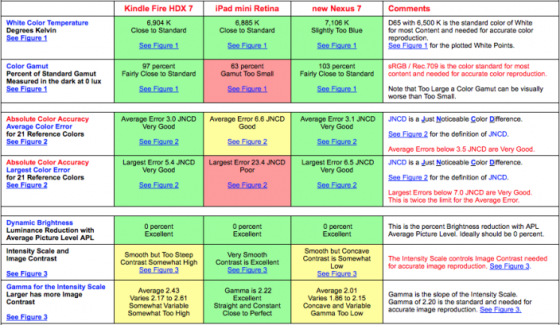Die Branchenprofis von DisplayMate, die sich auf das Testen und Kalibrieren von Displays vor dem finalen Produktionsstart spezialisiert haben, bescheinigen dem Retina Display im neuen iPad Mini Retina nicht nur gute Worte.
Mit den Worten „really bad planing“ nennen sie das iPad Mini IGZO Retina Display „out-dated technology“ und stellen es hinter dem neuen Google Nexus 7 und dem Amazon Kindle Fire HDX 7 auf Platz 3.
And finally… the iPad mini with Retina Display unfortunately comes in with a distant 3rd place finish behind the innovative displays on the Kindle Fire HDX 7 and new Nexus 7 […]
All of this reliance on IGZO is really bad planning… Right now there is a readily available display technology that has much higher performance than IGZO. It’s Low Temperature Poly Silicon LTPS, and it is used in all of the iPhones and in all of Samsung OLEDs (so it’s available in large quantities). Two innovative tablet manufacturers, Amazon and Google, have significantly leapfrogged Apple by introducing Tablet displays using LTPS (in the Kindle Fire HDX 8.9 and the new Nexus 7), and they are significantly outperforming the IGZO and a-Si displays in the current iPads. Apple is now lagging in displays, an area where it was once the leader…
DisplayMate nennt zwei Hauptprobleme, die beim Apple IGZO (Indium Gallium Zinc Oxide) Display bei objektiver Betrachtung auftauchen. Zum einen war IGZO zwar vor zwei Jahren die beste, verfügbare Displaytechnologie, doch im Bereich der Displaytechnologien hat sich mit LTPS, wie es im Kindle Fire und Google Nexus 7 zum Einsatz kommt eine signifikant besser Technologie vorgeschoben.
Zweitens, so Display Mate, ist IGZO wesentlich aufwändiger zu produzieren weshalb Apple in seinen iPads auch weniger effiziente Silicon a-Si Displays zum Einsatz bring.
This has created a production problem where Apple is using both IGZO and a-Si displays in the current iPads. The problem is that a-Si has much lower power efficiency than IGZO, so it uses much more power and also needs bigger batteries. So how can Apple use both display technologies in the same product? I’ve been told by using much higher performance (and cost) White LEDs in the Backlight of the a-Si panels, which equalizes the power efficiency for both types of displays in different ways. As a result, both types of displays can be engineered into the same Tablet and can provide comparable results for the consumer.
DisplayMate kritisiert in erster Linie, dass Apple Zugriff auf neuere Technologien gehabt hätte, diese aber zugunsten von vertrauter Technik außen vor gelassen hätte. Denn die derzeit beste Technologie namens Quantum Dots Display, die zum Beispiel das Kindle Fire HDX 7 nutzt, nutzt Apple nicht.
Quantum Dots are almost magical because they use Quantum Physics to produce highly saturated primary colors for LCDs that are similar to those produced by OLED displays. They not only significantly increase the size of the Color Gamut by 40-50 percent but also improve the power efficiency by an additional 15-20 percent. Instead of using White LEDs (which have yellow phosphors) that produce a broad light spectrum that makes it hard to efficiently produce saturated colors, Quantum Dots directly convert the light from Blue LEDs into highly saturated primary colors for LCDs. You can see the remarkable difference in their light spectra in Figure 4. Quantum Dots are going to revolutionize LCDs for the next 5+ years.
DisplayMate gab dem iPad Mini mit Retina Display in zahlreichen Kategorien top Wertungen, lobte Auflösung, geringe Farbverfälschungen durch unterschiedliche Betrachtungswinkel, „nahezu perfekte“ Kontrastwerte, exakte Kalibrierung, geringen Reflexionen, „sehr gute“ maximale Helligkeit, top Schwarzwerte und nahezu perfekte Sichtbarkeit bei hellem Licht.
Die schlechteste Wertung erhielt das iPad Mini Retina für die Rubrik Farbvielfalt, das heißt die Anzahl der darstellbaren Farben. Hier erhielt das iPad lediglich 63 Prozent, während der Amazon Kindle Fire HDX 97 und das Google Nexus 7 sogar 103 Prozent erhielt.
Insgesamt ein äußerst interessanten und vor allem objektiver Bericht von echten Profis. Wenn euch die Details der Materie interessieren, findet ihr den gesamten Bericht auf DisplayMate.com

